
Arncliffe is a suburb in southern Sydney, in the state of New South Wales, Australia. Arncliffe is located 11 kilometres south of the Sydney central business district, in the local government area of the Bayside Council.
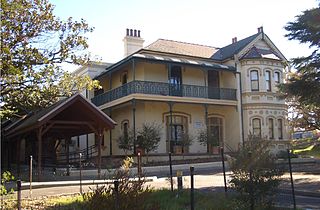
Turrella (;) is a suburb in southern Sydney, in the state of New South Wales, Australia. Turrella is located 10 km south-west of the Sydney central business district on the southern bank of Wolli Creek in the local government area of Bayside Council.

Elizabeth Farm is a historic estate located at 70 Alice Street, Rosehill, a suburb of Sydney, New South Wales, Australia. Elizabeth Farm was the family home of wool pioneers John and Elizabeth Macarthur. The estate was commenced in 1793 on a slight hill overlooking the upper reaches of Parramatta River, 23 kilometres (14 mi) west of Sydney Cove. The Burramattagal clan of the Dharug people are the traditional custodians of the area; their presence is recalled in the name Parramatta.

Vaucluse House is a heritage-listed residence, colonial farm and country estate and now tourist attraction, house museum and public park, formerly the home of statesman William Charles Wentworth and his family. It is located at 69a Wentworth Road, Vaucluse in the Municipality of Woollahra local government area of New South Wales, Australia. Completed between 1803 and 1839 in the Gothic Revival style, its design was attributed to W. C. Wentworth and built by Sir Henry Browne Hayes and W. C. Wentworth. The property is owned by the Historic Houses Trust of New South Wales, an agency of the Government of New South Wales. The site was added to the New South Wales State Heritage Register on 2 April 1999.
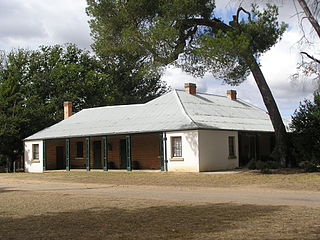
Riversdale is a heritage-listed house in the early colonial Regency style located in Goulburn, New South Wales, Australia. The house was built in about 1840 and some of the outbuildings were constructed even earlier. The house is listed on the New South Wales State Heritage Register and the property is owned by the National Trust of Australia. It was added to the New South Wales State Heritage Register on 1 March 2002.

Eryldene is a heritage-listed former family residence and now house museum located at 17 McIntosh Street in the Sydney North Shore suburb of Gordon, Australia. It was designed by William Hardy Wilson and built from 1913 to 1936 by Rudolph G. Ochs. The property is owned by The Eryldene Trust. The house and its garden, which is noted for its camellias was added to the New South Wales State Heritage Register on 2 April 1999 and was listed on the Australian Register of the National Estate.
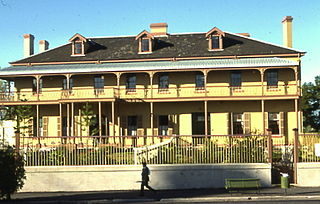
Juniper Hall, also known as Ormond House, is a heritage-listed former residence and children's home and now retail building and exhibition venue located at 1 Ormond Street, Paddington, Sydney, New South Wales, Australia. It was built from 1824 to 1825 by Robert Cooper. The two-storey Old Colonial Georgian house was added to the New South Wales State Heritage Register on 2 April 1999 and is listed on the Register of the National Estate

Bronte House is a heritage-listed historic house and visitor attraction located at 470 Bronte Road, Bronte, New South Wales, a beachside suburb of Sydney, Australia. Built in the Australian Gothic Revival style, the house was designed by Georgiana & Robert Lowe and Mortimer Lewis and built from 1843 to 1845. It is also known as Bronte estate. The property is owned by Waverley Municipal Council and was added to the New South Wales State Heritage Register on 2 April 1999 and is listed on the Register of the National Estate.

Yasmar is a heritage-listed house at 185 Parramatta Road, Haberfield, Inner West Council, Sydney, New South Wales, Australia. It has variously served as a private home, Sunday school, children's court and juvenile remand and detention centre, and is now used by community groups and as a correctional services training facility. It was designed by John Bibb and built from 1856 to 1858. The surrounding site has also been known as Yasmar Hostel, Yasmar Detention Centre, Yasmar Child Welfare Home, Ashfield Remand Home, Yasmar Shelter and the Yasmar Juvenile Justice Centre. The property is owned by Land and Property Management Authority (LPMA). It was added to the New South Wales State Heritage Register on 18 February 2000.

The Bunyas is a heritage-listed residence and former church missionary and scout headquarters at 5 Rogers Avenue, Haberfield, New South Wales, a suburb of Sydney, Australia. It was designed by John Spencer-Stansfield and built from 1900 to 1907. It is also known as Stanton Residence. It was added to the New South Wales State Heritage Register on 2 April 1999.
Wilsons Farm House is a heritage-listed former residence at 310 West Botany Street, Rockdale, Bayside Council, New South Wales, Australia. It was built from 1855 to 1856 by James Wilson. The property is owned by Bayside Council. It was added to the New South Wales State Heritage Register on 2 April 1999.
Arncliffe Market Gardens is a heritage-listed market garden at 212 West Botany Street, Banksia, New South Wales, a suburb of Sydney, Australia. It was established from 1892 by Sun Kuong-War. It is also known as West Botany Street Market Gardens, Rockdale Market Gardens and Chinese Market Gardens. It was added to the New South Wales State Heritage Register on 2 April 1999.
Tomago House is a heritage-listed former residence and now house museum and function centre at Tomago Road, Tomago, New South Wales, Australia. It was built from 1838 to 1840. The design has been attributed to Mortimer Lewis. The property is owned by the National Trust of Australia (NSW). It was added to the New South Wales State Heritage Register on 2 April 1999.
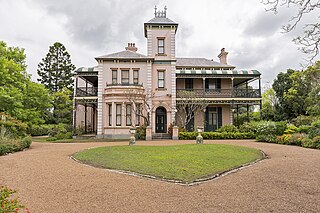
Cintra House is a heritage-listed residence and one-time private hospital at 34 Regent Street, Maitland, City of Maitland, New South Wales, Australia. It was designed by John Wiltshire Pender with a garden by Sydney landscape architect R. Culbert. It was built from 1879 by Robert James with an 1887 extension by H. Noad. It is also known as Cintra. It was added to the New South Wales State Heritage Register on 31 August 2012.

The Wolli Creek Aqueduct is a heritage-listed sewage aqueduct located at Unwin Street, Earlwood, City of Canterbury-Bankstown, New South Wales, Australia.

Laurelbank is a heritage-listed former residence and now function centre at 85–87 Penshurst Street, Willoughby, City of Willoughby, New South Wales, Australia. It was built from 1850 to 1884. The property is owned by the Laurelbank Masonic Centre Pty Ltd, a community group. It was added to the New South Wales State Heritage Register on 2 April 1999.

Hillview is a heritage-listed former residence and now boutique hotel at Old Illawarra Highway, Sutton Forest, Wingecarribee Shire, New South Wales, Australia. It was the official country residence of the Governor of New South Wales from 1882 to 1957. The house had formerly been known as Prospect. It was added to the New South Wales State Heritage Register on 2 April 1999.

The Briars is a heritage-listed residence located at 14 Woonona Avenue, in the Sydney suburb of Wahroonga, New South Wales, Australia. It was designed by Charles H. Halstead. It was added to the New South Wales State Heritage Register on 2 April 1999.
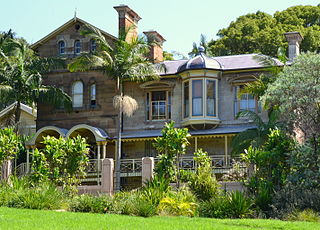
Ewenton is a heritage-listed residence at 1 Blake Street, Balmain, Inner West Council, Sydney, New South Wales, Australia. It was designed by James McDonald and built from 1854 to 1872. It is also known as Blake Vale. It was added to the New South Wales State Heritage Register on 2 April 1999.

Milton Terrace is a heritage-listed series of terrace houses located at 1–19 Lower Fort Street, in the inner city Sydney suburb of Millers Point in the City of Sydney local government area of New South Wales, Australia. It was built from 1880 to 1882. The property was added to the New South Wales State Heritage Register on 2 April 1999.


















